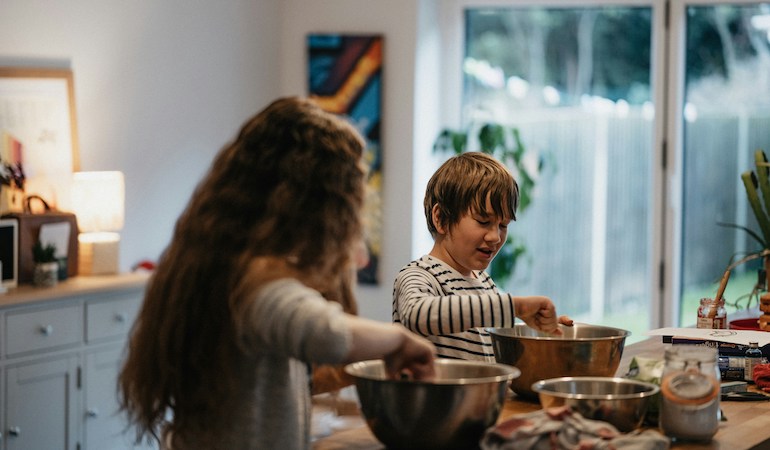I have a child who has always struggled to get ready in the morning. When my kids were young, Lily’s morning struggles affected the whole family as we made our way toward the door, toward the car, and toward school.
After a particularly challenging morning when Lily was three, I realized that I needed to figure out how to help them to be more independent with their morning routine.
I started by observing. I discovered that getting dressed was a particular challenge in the morning, and the fewer things that needed to happen between waking up and getting in the car, the better.
I found that Lily could get up out of bed, they could go to the bathroom, and they were happy to brush their teeth because they didn’t like the feel of the ‘sweaters on their teeth’ that would grow if they didn’t brush their teeth at least twice a day.
The evening time before bed was, in contrast, a great time for Lily. So, they started getting dressed for the next day each night as a part of their bedtime routine. We packed their breakfast into their lunch bag so that they could eat when they got to morning care. And, I prepared an inviting nest in the car so that after brushing their teeth, Lily was drawn to the car.
With these changes made, Lily was able to be more independent with evening and morning activities, and our family experience improved immensely.
By scaffolding Lily’s mornings when they were three, we helped them to exist more harmoniously in the family, showed them that we knew they were capable, and prepared them to add new pieces of difficulty to their routines when they were ready. Lily is now a fully functioning and very capable seventeen-year-old!
Laying the Foundation: Preparing the Physical Environment
One of the first steps in fostering independence is ensuring your home environment supports your child’s ability to act independently. This means rethinking how we organize our spaces – from the kitchen to the playroom.
Keys for Preparing Your Environments for Your Children’s Independence:
- Supplies in low cabinets
- Stools that can be used to reach counters easily
- Supplies for cleaning up messes are easily accessible and introduced to children
- Supplies set out on shelves in an organized way rather than in bins and baskets
- Age appropriate cookbooks
- Mollie Katzen has some great cookbooks for young children. We used all of them regularly when our kids were young.
- By the end of Lower Elementary or the beginning of Upper Elementary, experienced young chefs can use just about any cookbook. Enjoy discovering new favorite recipes together!
Kitchen Independence: A Recipe for Self-Reliance
The kitchen is a wonderful place for children to learn and grow. Through cooking, children not only learn about nutrition and mathematics but also gain valuable life skills. To support this, I recommend keeping a selection of cookbooks that cater to various ages and skill levels.
For our youngest chefs, books with simple instructions and illustrations invite participation and success. As children grow, more complex recipes introduce them to new challenges, including knife skills and heat management.
Some of our big work as parents is finding the balance between offering help and allowing independence. While it’s natural to want to step in and assist, we must remember that every unnecessary help is a missed opportunity for learning.
By observing our children and understanding their capabilities, we can provide just the right amount of support without undermining their ability to do things on their own.
Keys for Preparing Ourselves to Support Our Children’s Independence
- Share clear expectations about how spaces and objects can be used.
- The most important thing for us to remember as our children’s guides through childhood is to not provide unnecessary help. For this, we must know our children well. Rather than offering to do things for your child when he/she is struggling, observe to figure out what strategies will help your child to be successful in completing tasks on his or her own.
- Remember that supporting our children’s independence means leaving time for them to do things for themselves. We often step in for efficiency rather than because our children are not capable of doing the tasks at hand.
- Observe and know your child. Spend time observing to see what works and doesn’t work with your child. If you find that he struggles to remember his morning tasks, brainstorm strategies to help him remember. If he needs more time, talk to him about figuring out the right amount of time and get him up early enough so that he has enough time. If he just can’t choose an outfit, talk to him on the weekend about planning outfits for the week…
Lessons on Navigating Challenges
In our journey to encourage independence, it’s inevitable that our children will face challenges. Whether it’s mastering a morning routine or learning to clean up after themselves, identifying and isolating the difficulty can help us guide them more effectively. Offering targeted lessons or support on specific tasks can make a significant difference. For example, teaching children how to properly use a knife or clean up spills equips them with the skills to tackle these tasks confidently.
Important Lessons to Include:
- Navigating more dangerous/precarious activities:
- How to use knives
- How to use the stove
- How to use the oven
- How to clean up.
- Grace and Courtesy when you see sticky situations. If you notice your child doesn’t wrap the cheese before returning it to the refrigerator, give a lesson on how to wrap the cheese. If you notice your child spills water every time he fills his glass, give him a lesson on how to dry the floor including where the supplies are kept and what to do with them once they have been used.
A central principle in this kind of work is to isolate the difficulty. When we are giving lessons, we introduce one new piece of challenge with each one. Everything is familiar except for the one new thing.
At home, this means breaking tasks down into manageable pieces. If you find that your child struggles to complete his morning routine, try to isolate the difficulty. Is he struggling because he doesn’t remember what to do, because he doesn’t have enough time to complete all of the tasks, or because he needs scaffolding to be successful with some of the tasks?
Cultivating a Culture of Independence
Ultimately, fostering independence is about more than just practical skills—it’s about cultivating a mindset. By setting up our homes to support autonomy, setting clear expectations, and thoughtfully guiding our children through challenges, we lay the groundwork for a lifetime of self-reliance and resilience.
Remember, the goal is not perfection but progress. Celebrate the small victories and learn from the setbacks. Independence doesn’t happen overnight, but with patience, observation, and consistent support, we can empower our children to navigate the world with confidence and curiosity.
In embracing these principles, we not only prepare our children for the practical aspects of daily life but also nurture their emotional intelligence and inner strength. As we guide them toward independence, we give them the greatest gifts of all: a sense of competence, the joy of learning, and the confidence to face whatever comes their way.

As the Director of Education for Elementary and career-long Montessori educator, Minnie relishes the gift that a Montessori education offers to children, families, and society.





